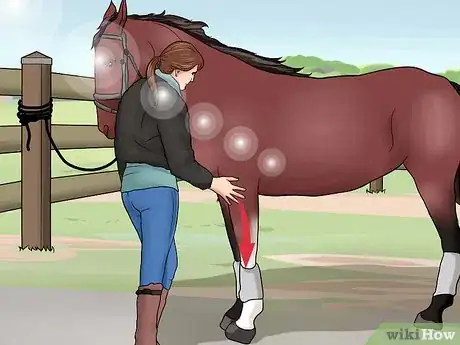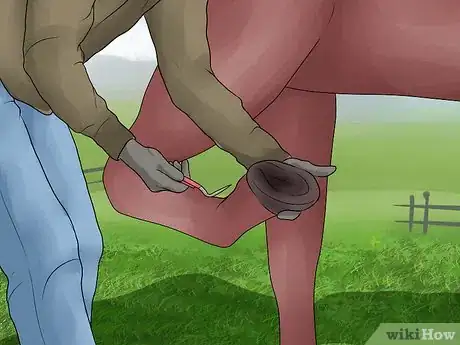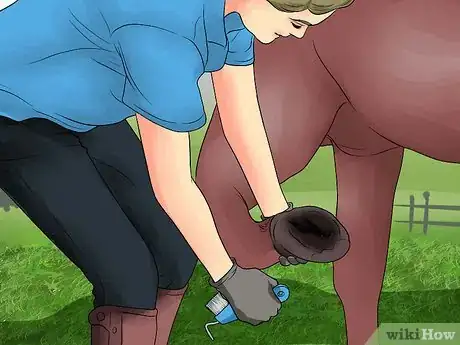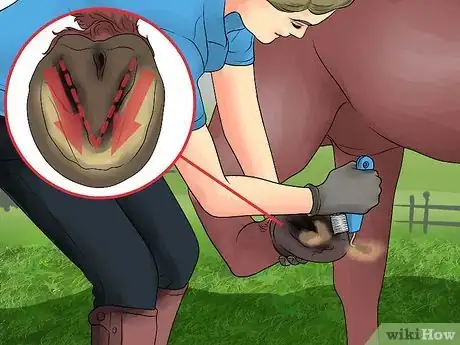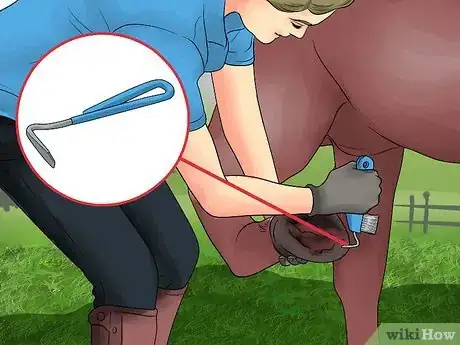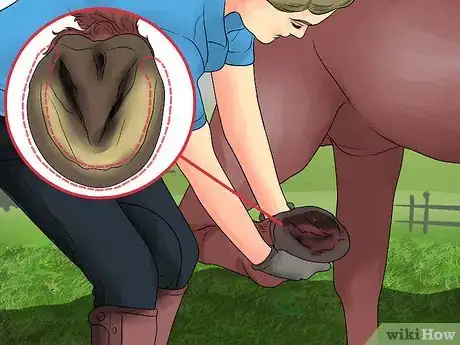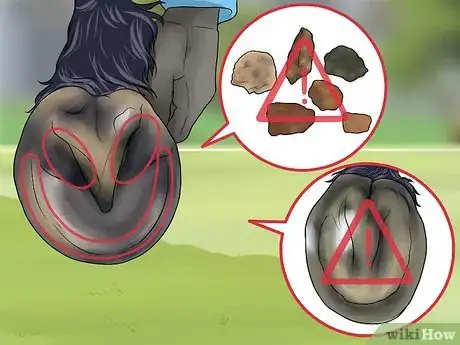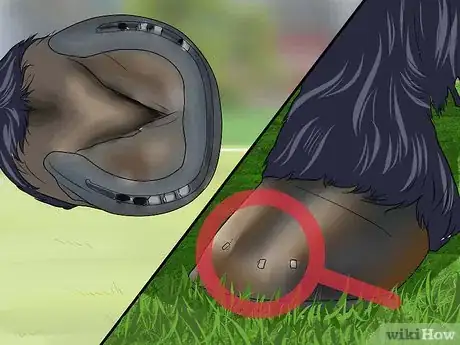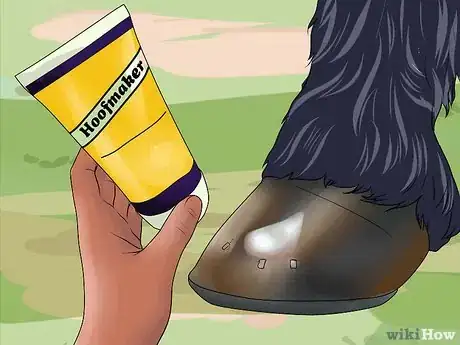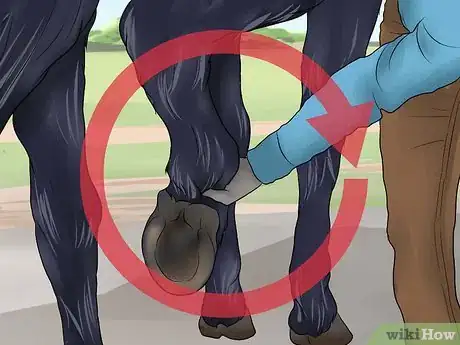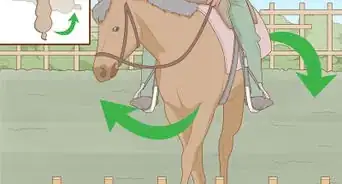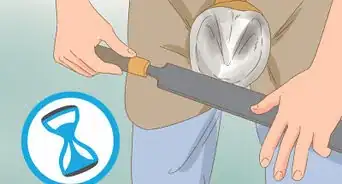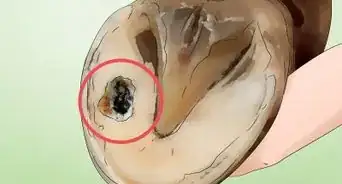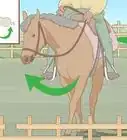This article was co-authored by Pippa Elliott, MRCVS. Dr. Elliott, BVMS, MRCVS is a veterinarian with over 30 years of experience in veterinary surgery and companion animal practice. She graduated from the University of Glasgow in 1987 with a degree in veterinary medicine and surgery. She has worked at the same animal clinic in her hometown for over 20 years.
wikiHow marks an article as reader-approved once it receives enough positive feedback. In this case, several readers have written to tell us that this article was helpful to them, earning it our reader-approved status.
This article has been viewed 211,882 times.
When you picking out a horse hoof, you remove mud, bedding, and any stones compacted in the underside of the hoof. You do this using a tool called a hoof pick. Picking out hooves is a very important skill, and should be done daily before and after riding to help keep the horse sound and from going lame. If the hoof is not picked and a stone becomes lodged in the hoof, it's possible the weight of the horse could push the stone right through the sole, which can have serious consequences. If you follow a few simple steps, you can learn to pick your horse's hoof correctly and prevent him from getting hurt.
Steps
Readying Your Horse for Picking
-
1Calm the horse. Before you can start, you need to make sure your horse is calm. You should also make sure he does not want to wander off. You need to start in a calm area, because it is not possible to get your horse to stand on 3 legs if there is a lot of excitement around him.
- You should tie your horse up. Make sure the rope that is holding them isn't too tight. This is so that, if the horse panics, he won't hurt his neck by jarring it against the bridle.
- Make sure that the rope isn't too short, which could cause discomfort or panic. Also make sure the rope isn't tied too long, as the grazing instinct might take over and throw off the horse's balance if he lowers his head.[1]
-
2Start on one side. When you approach the horse, introduce yourself, and let the horse know you have good intentions. Give him gentle strokes on his neck and shoulder and speak to him softly. Stand near the shoulder of one side and turn your body to face his tail. For a horse that may kick, make sure that your body is positioned comfortably and safely.
- When you plant yourself next to your horse, have your outside leg slightly in front of the other for better balance and efficient maneuvering.[2]
- Get into a routine with the horse so that he recognized what you're about to do. This will make it easier on you because he will be more likely to cooperate.
- It is a good idea to start with a front leg so you can gauge the horse's mood whilst being further away from the more dangerous back end.[3]
Advertisement -
3Warn the horse. When you are firmly standing beside him, run your hand down your horse's leg, then tap at the back of his leg. This should warn the horse what you are about to do, which will give him time to square himself up. You want to make sure your horse does this, because if the other three legs are positioned too awkwardly, you will not be able to pick his hoof.
- He won't pick up a leg if he feels unbalanced, so give him a chance to sort himself out.[4]
-
4Lift his leg. Once he is settled, give your horse time to lift his foot. You can squeeze the leg above the fetlock, which is the hinge joint above the hoof, if the horse doesn't automatically pick up the leg at the first command.[5] Have patience and be gentle, as this may take some convincing if the horse is not responding.
- If he still won't pick up his leg, gently lean against his shoulder. This sometimes helps to push his balance to his other side. Be careful to do it slowly so he can shift his weight.
- If all other attempts to get him to lift his leg have failed, gently squeeze his chestnut, which is the hard, oval growth above the knee on the inside of the leg. Be gentle and wait a second for the leg to lift. You should release it as soon as you get a response.
- If nothing else works, talk to him and make clicking noises with your mouth to make sure he is paying attention. If a normally obedient horse will not raise a leg, check for lameness.
-
5Support the hoof. Once you get him to raise his hoof, hold the hoof in one hand. If he tries to pull away or put his foot down, hold the toe of the hoof and lift it towards his elbow. Support the hoof with the hand closest to the horse's body, leaving the hand furthest from the horse to wield the hoof pick. This allows you the best position to put your body against the horse, and feel what movements the horse is making.
-
6Relax your pull. Once you finally get the horse's hoof supported in your hand and your horse relaxes, you can release the strength of your hold on the leg. You don't have to pull it so hard once he relaxes into the position. As soon as he does, you will only need minimal effort because the hold takes very little strength.
- If you relax, he is less likely to stamp his hoof down.
- Once the horse standing calmly on 3 legs, you can actually start picking the hoof.
- Do not pull the horses leg out toward you. You want to keep it in its natural place. If you pull it in an unnatural way, you will cause the horse serious pain.[8]
Picking Your Horse's Hoof
-
1Remove material from the frog. Once you have the horse hoof in your hand, you can start the picking process. Begin by removing any material from the frog, which V or triangular wedge shape that protrudes from the horse's heel towards his head, with your fingers or a brush rather than the pick. The frog is a sensitive part of the hoof that has a blood supply and nerve endings. It should be treated like any other sensitive part of the horse and handled with care.
- The frog sometimes shreds. If it looks tatty and ragged, gently tug it with your fingers. If it doesn't come away, it is probably pieces of the frog and you should leave it to come away by itself.
- If necessary, call a qualified farrier or hoof trimmer to trim it for you. If the frog is flaky, never be tempted to cut it back yourself. You can quickly go too deep and cut into living tissue, which could then cause your horse to go lame. [9]
-
2Clean the hoof. When cleaning, use the point of the hoof pick to gently loosen any stones and pry them free. Never dig the point into the sole or hoof. You should only use the point to gain leverage on stones. Use the edge of the hoof pick to loosen dirt, mud, and debris. Work away with steady strokes until you can see the horn that forms the horse's hoof.
- It is best to work from heel to toe, to prevent accidentally damaging the heel area or stabbing yourself with the hoof pick.
- Always work the hoof pick away from the frog. This means that you should start close to the frog and move the hoof pick away from it. This prevents accidentally piercing the frog with the pick.
- Never apply pressure down towards the hoof, always use a wiping or swiping type motion, parallel to the hoof so as not to risk penetrating it.[10]
-
3Examine the horn. While you are picking the heel, you should look at the state of the horn, which is the layer of tough skin that surrounds inside of hoof wall. The horn of the hoof should look dry and be free from cracks or moist discharges.
- If you see cracks, fissures, or a discharge, either in the form of pus or white, foul smelling discharge, contact your veterinarian immediately.[11]
-
4Pay particular attention to sensitive areas. These areas are along the cleft of the frog and around the white line area. These areas may get small stones stuck in them, which can be irritating and cause serious damage if left unchecked. Also check for thrush, characterized by a flaky white powder on the horse's hoof or frog. It will flake when scratched with the hoof pick. It's a common and potentially fatal hoof disease caused by wet or muddy conditions in a pasture or stall.[12]
- Much like the horn, you need to check to make sure the frog looks dry and there is no discharge or smelly material exuding from it. Place your palm over the frog to ensure it is not hot. A warm, tender frog is a sign of inner infection which needs prompt veterinary attention.[13]
-
5Check hoof health. Once you have gotten all the debris out of the hoof and you have checked the horn and the frog, you need to make sure that the hoof is in good shape. Check the sole of the hoof, which should be hard and concave. You also need to ensure that the hoof is balanced and not in need of trimming. The horse should be able to stand squarely with all hooves in contact with the ground.
- Check for bruises and cracks within the hoof. If the horse is reluctant to put one hoof down, this could be a sign of pain or discomfort. If you notice this, pay particular attention to that leg when you check the hoof.[14]
-
6Examine the clenches. If your horse has shoes on, make sure the clenches, which are the nails that hold the shoe on, haven't risen. You will most likely know if they have risen when the clenches slice your hand. Try to shake the shoe to make sure that the shoe is not loose. Put the hoof down gently.
- If the shoe is loose, book a qualified farrier to replace it as quickly as possible. Put a hoof boot or bandage over a loose shoe to keep it in place until the farrier can come.
- Some horses do best with shoes, and some do best barefoot. Find a qualified farrier to discuss which is best for your horse.
-
7Apply salve or conditioner if necessary. If your horse's hoof is extremely dried out, feels overly rough, or is in need of conditioning, you can add some hoof conditioner. There are many different brands of hoof conditioner or salve, such as Equine Squire Drawing Salve or Hoof maker, that can help rejuvenate your horse's hoof.
- You can make your own conditioner for your horse's hoof with coconut oil. You can also add one part aloe vera and one part glycerin to two parts coconut oil for a more intense conditioner for your horse's hooves.[15]
- If your horse has an infection or other bacteria infection in her hoof, you can also get ointments such as ichthammol to help relieve pain, reduce inflammation, and kill germs.[16]
-
8Attend the other three legs. Once you have completed the full examination of one leg, you need to repeat the same procedure for each leg. When picking the rear hooves, stand right against the side of the horse's rump with your back to the horse's head facing towards his tail. Never stand directly behind the horse. If he kicked out, you would be seriously injured.
- Take care not to surprise the horse. You should run your hand down his back, over the rump, and right the way down the hind leg to his fetlock. Ask the horse to lift the back leg in the same way you did the front. Because you are standing to the side of the horse, should he kick out, just let go of the hoof and you will not get hurt.
- You should try to check the legs in the same order each time.[17]
Expert Q&A
-
QuestionIf your horse kicks you when you aren't doing anything, what does it mean?
 Pippa Elliott, MRCVSDr. Elliott, BVMS, MRCVS is a veterinarian with over 30 years of experience in veterinary surgery and companion animal practice. She graduated from the University of Glasgow in 1987 with a degree in veterinary medicine and surgery. She has worked at the same animal clinic in her hometown for over 20 years.
Pippa Elliott, MRCVSDr. Elliott, BVMS, MRCVS is a veterinarian with over 30 years of experience in veterinary surgery and companion animal practice. She graduated from the University of Glasgow in 1987 with a degree in veterinary medicine and surgery. She has worked at the same animal clinic in her hometown for over 20 years.
Veterinarian It could be the horse was surprised in the past by someone walking up behind him, and now he preemptively lashes out because he associates people near him as a threat. He may also have learnt that when he kicks out, people keep their distance. Thus he gets out of doing things that he doesn't want to do. This is a potentially dangerous situation, so be sure to seek advice from a professional behaviorist or horseman about how to retrain the horse.
It could be the horse was surprised in the past by someone walking up behind him, and now he preemptively lashes out because he associates people near him as a threat. He may also have learnt that when he kicks out, people keep their distance. Thus he gets out of doing things that he doesn't want to do. This is a potentially dangerous situation, so be sure to seek advice from a professional behaviorist or horseman about how to retrain the horse. -
QuestionWhy does my pony rear when I go to clean out his hoof?
 Pippa Elliott, MRCVSDr. Elliott, BVMS, MRCVS is a veterinarian with over 30 years of experience in veterinary surgery and companion animal practice. She graduated from the University of Glasgow in 1987 with a degree in veterinary medicine and surgery. She has worked at the same animal clinic in her hometown for over 20 years.
Pippa Elliott, MRCVSDr. Elliott, BVMS, MRCVS is a veterinarian with over 30 years of experience in veterinary surgery and companion animal practice. She graduated from the University of Glasgow in 1987 with a degree in veterinary medicine and surgery. She has worked at the same animal clinic in her hometown for over 20 years.
Veterinarian It may be the pony has learnt that by rearing, you back off. Thus he uses it as an effective strategy to get out of doing something he doesn't want to. Alternatively, he may have a pain in the hoof and he's anxious for you not to touch it because it will be sore. If the pony is lame at all then speak to a vet or a qualified farrier. If he's otherwise sound then gently retrain him to accept having his feet touched.
It may be the pony has learnt that by rearing, you back off. Thus he uses it as an effective strategy to get out of doing something he doesn't want to. Alternatively, he may have a pain in the hoof and he's anxious for you not to touch it because it will be sore. If the pony is lame at all then speak to a vet or a qualified farrier. If he's otherwise sound then gently retrain him to accept having his feet touched.
References
- ↑ https://www.youtube.com/watch?v=ifVd2ir0_mM
- ↑ https://www.youtube.com/watch?v=ifVd2ir0_mM
- ↑ https://www.aspca.org/pet-care/virtual-pet-behaviorist/horse-behavior/handling-your-horses-hooves
- ↑ https://www.youtube.com/watch?v=ifVd2ir0_mM
- ↑ http://www.bloodhorse.com/horse-racing/articles/55678/the-horses-fetlock-joint-injury-disease-and-repair
- ↑ https://www.aspca.org/pet-care/virtual-pet-behaviorist/horse-behavior/handling-your-horses-hooves
- ↑ http://equusmagazine.com/article/pasternproblems_012706
- ↑ https://www.youtube.com/watch?v=ifVd2ir0_mM
- ↑ https://www.youtube.com/watch?v=ifVd2ir0_mM
- ↑ https://www.aspca.org/pet-care/virtual-pet-behaviorist/horse-behavior/handling-your-horses-hooves
- ↑ https://www.aspca.org/pet-care/virtual-pet-behaviorist/horse-behavior/handling-your-horses-hooves
- ↑ https://www.youtube.com/watch?v=ifVd2ir0_mM
- ↑ https://www.aspca.org/pet-care/virtual-pet-behaviorist/horse-behavior/handling-your-horses-hooves
- ↑ https://www.aspca.org/pet-care/virtual-pet-behaviorist/horse-behavior/handling-your-horses-hooves
- ↑ http://www.cowboyway.com/HowTo/HomemadeHoofConditioner.htm
- ↑ http://equusmagazine.com/article/ten-reasons-to-love-sticky-ichthammol-ointment-8477
- ↑ https://www.aspca.org/pet-care/virtual-pet-behaviorist/horse-behavior/handling-your-horses-hooves
About This Article
To pick a horse’s hoof, wait until the horse is calm, the stand next to one of the horse’s front shoulders. Run your hand down the horse’s leg and tap it at the back of the leg so it will lift its foot. Use the hand clsoest to the horse to hold the hoof to steady it. Use the fingers of your free hand to brush material out of the V-shaped indentation in the horse’s hoof, then use the point of the hoof pick to gently loosen any dirt or stones and pry them free. Never dig the point into the sole or hoof. For tips from our veterinary reviewer on examining your horse’s hoof once it’s clean, keep reading!


